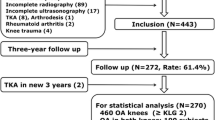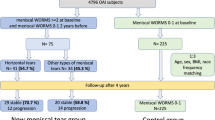Abstract
Objectives
To assess whether partial meniscectomy is associated with increased risk of radiographic osteoarthritis (ROA) and worsening cartilage damage in the following year.
Methods
We studied 355 knees from the Osteoarthritis Initiative that developed ROA (Kellgren-Lawrence grade ≥ 2), which were matched with control knees. The MR images were assessed using the semi-quantitative MOAKS system. Conditional logistic regression was applied to estimate risk of incident ROA. Logistic regression was used to assess the risk of worsening cartilage damage in knees with partial meniscectomy that developed ROA.
Results
In the group with incident ROA, 4.4 % underwent partial meniscectomy during the year prior to the case-defining visit, compared with none of the knees that did not develop ROA. All (n = 31) knees that had partial meniscectomy and 58.9 % (n = 165) of the knees with prevalent meniscal damage developed ROA (OR = 2.51, 95 % CI [1.73, 3.64]). In knees that developed ROA, partial meniscectomy was associated with an increased risk of worsening cartilage damage (OR = 4.51, 95 % CI [1.53, 13.33]).
Conclusions
The probability of having had partial meniscectomy was higher in knees that developed ROA. When looking only at knees that developed ROA, partial meniscectomy was associated with greater risk of worsening cartilage damage.
Key Points
• Partial meniscectomy is a controversial treatment option for degenerative meniscal tears.
• Partial meniscectomy is strongly associated with incident osteoarthritis within 1 year.
• Partial meniscectomy is associated with increased risk of worsening cartilage damage.


Similar content being viewed by others
Abbreviations
- MRI:
-
Magnetic resonance imaging
- ROA:
-
Radiographic osteoarthritis
- RCT:
-
Randomized controlled trial
- OAI:
-
Osteoarthritis Initiative
- K-L:
-
Kellgren-Lawrence
- P0:
-
OAI annual visit when radiographic osteoarthritis was diagnosed
- P-1:
-
OAI annual visit 1 year prior to diagnosis of radiographic osteoarthritis
References
Lubowitz JH, Poehling GG (2011) Save the meniscus. Arthroscopy 27:301–302
Burns TC, Giuliani JR, Svoboda SJ, Owens BD (2011) Meniscus repair and transplantation techniques. J Knee Surg 24:167–174
Englund M, Lohmander LS (2004) Risk factors for symptomatic knee osteoarthritis fifteen to twenty-two years after meniscectomy. Arthritis Rheum 50:2811–2819
Englund M, Roemer FW, Hayashi D, Crema MD, Guermazi A (2012) Meniscus pathology, osteoarthritis and the treatment controversy. Nat Rev Rheumatol 8:412–419
Herrlin SV, Wange PO, Lapidus G, Hallander M, Werner S, Weidenhielm L (2013) Is arthroscopic surgery beneficial in treating non-traumatic, degenerative medial meniscal tears? A five year follow-up. Knee Surg Sports Traumatol Arthrosc 21:358–364
Katz JN, Brophy RH, Chaisson CE et al (2013) Surgery versus physical therapy for a meniscal tear and osteoarthritis. N Engl J Med 368:1675–1684
Yim JH, Seon JK, Song EK et al (2013) A comparative study of meniscectomy and nonoperative treatment for degenerative horizontal tears of the medial meniscus. Am J Sports Med 41:1565–1570
Sihvonen R, Paavola M, Malmivaara A et al (2013) Arthroscopic partial meniscectomy versus sham surgery for a degenerative meniscal tear. N Engl J Med 369:2515–2524
Gauffin H, Tagesson S, Meunier A, Magnusson H, Kvist J (2014) Knee arthroscopic surgery is beneficial to middle-aged patients with meniscal symptoms: a prospective, randomised, single-blinded study. Osteoarthr Cartil 22:1808–1816
Thorlund JB, Juhl CB, Roos EM, Lohmander LS (2015) Arthroscopic surgery for degenerative knee: systematic review and meta-analysis of benefits and harms. BMJ 350:h2747
Roemer FW, Kwoh CK, Hannon MJ et al (2015) What comes first? Multi-tissue involvement leading to radiographic osteoarthritis: MRI-based trajectory analysis over 4 years in the Osteoarthritis Initiative. Arthritis Rheumatol 67:2085–2096
Katz JN, Martin SD (2009) Meniscus—Friend or foe: epidemiologic observations and surgical implications. Arthritis Rheum 60:633–635
Peterfy CG, Schneider E, Nevitt M (2008) The osteoarthritis initiative: report on the design rationale for the magnetic resonance imaging protocol for the knee. Osteoarthr Cartil 16:1433–1441
Nevitt MC, Felson DT, Lester G. The Osteoarthritis Initiative: protocol for the cohort study. p. 19–20. URL: http://oai.epi-ucsf.org/datarelease/docs/StudyDesignProtocol.pdf. Accessed June 23, 2015
Radiographic procedure manual for examinations of the knee, hand, pelvis and lower limbs. Version 2.1. August 2006. URL: http://oai.epi-ucsf.org/datarelease/operationsManuals/RadiographicManual.pdf. Accessed June 23, 2015
Kothari M, Guermazi A, von Ingersleben G et al (2004) Fixed–flexion radiography of the knee provides reproducible joint space width measurements in osteoarthritis. Eur Radiol 14:1568–1573
Appendix A. Project 15: reader discrepancies and adjudication procedures. OAI central reading of knee x-rays for K-L grade and individual features of knee OA 2013; p. 8. URL: http://oai.epi-ucsf.org/datarelease/forms/kXR_SQ_BU_Descrip.pdf?V01XRKL. Accessed June 23, 2015
Hunter DJ, Guermazi A, Lo GH et al (2011) Evolution of semi-quantitative whole joint assessment of knee OA: MOAKS (MRI Osteoarthritis Knee Score). Osteoarthr Cartil 19:990–1002
Roemer FW, Hunter DJ, Crema MD, Kwoh CK, Ochoa-Albiztegui E, Guermazi A (2015) An illustrative overview of semi-quantitative MRI scoring of knee osteoarthritis: lessons learned from longitudinal observational studies. Osteoarthr Cartil. doi:10.1016/j.joca.2015.08.011
Landis JR, Koch GG (1977) The measurement of observer agreement for categorical data. Biometrics 33:159–174
Nepple JJ, Wright RW, Matava MJ, Brophy RH (2012) Full-thickness knee articular cartilage defects in national football league combine athletes undergoing magnetic resonance imaging: prevalence, location, and association with previous surgery. Arthroscopy 28:798–806
Stein T, Mehling AP, Welsch F, von Eisenhart-Rothe R, Jager A (2010) Long-term outcome after arthroscopic meniscal repair versus arthroscopic partial meniscectomy for traumatic meniscal tears. Am J Sports Med 38:1542–1548
Englund M, Guermazi A, Roemer FW, et al (2009) Meniscal tear in knees without surgery and the development of radiographic osteoarthritis among middle-aged and elderly persons: The Multicenter Osteoarthritis Study. Arthritis Rheum
Englund M, Guermazi A, Gale D et al (2008) Incidental meniscal findings on knee MRI in middle-aged and elderly persons. N Engl J Med 359:1108–1115
Amin S, LaValley MP, Guermazi A et al (2005) The relationship between cartilage loss on magnetic resonance imaging and radiographic progression in men and women with knee osteoarthritis. Arthritis Rheum 52:3152–3159
Kim SJ, Lee SK, Kim SH et al (2015) Does decreased meniscal thickness affect surgical outcomes after medial meniscectomy? Am J Sports Med 43:937–944
Alizai H, Roemer FW, Hayashi D, Crema MD, Felson DT, Guermazi A (2015) An update on risk factors for cartilage loss in knee osteoarthritis assessed using MRI-based semiquantitative grading methods. Eur Radiol 25:883–893
Bloecker K, Wirth W, Guermazi A, Hitzl W, Hunter DJ, Eckstein F (2015) Longitudinal change in quantitative meniscus measurements in knee osteoarthritis-data from the Osteoarthritis Initiative. Eur Radiol 25:2960–2968
Van Dyck P, Vanhevel F, Vanhoenacker FM et al (2015) Morphological MR imaging of the articular cartilage of the knee at 3 T-comparison of standard and novel 3D sequences. Insights Imaging 6:285–293
Katz JN, Losina E (2014) Arthroscopic partial meniscectomy for degenerative tears: where do we stand? Osteoarthr Cartil 22:1749–1751
Acknowledgments
The scientific guarantor of this publication is the first author, Frank Roemer. The data were presented at RSNA and at ECR 2015 as a podium presentation.
The authors of this manuscript declare no relationships with any companies, whose products or services may be related to the subject matter of the article.
The authors of this manuscript declare relationships with the following companies outside of this work: Dr. Guermazi has received consultancies, speaking fees, and/or honoraria from OrthoTrophix, Genzyme, Merck Serono and TissueGene, and is President and shareholder of Boston Imaging Core Lab (BICL), LLC, a company providing image assessment services. Dr. Roemer is Chief Medical Officer and shareholder of BICL, LLC. Dr. Kwoh has provided consulting services to Novartis and has received research support from AstraZeneca. Dr. Eckstein is CEO of Chondrometrics GmbH, a company providing MR image analysis services to academic researchers and to industry. He provides consulting services to Merck Serono, Novartis, and Sanofi-Aventis, has received speaker honoraria from Merck, Glaxo-Smith-Kline, Genzyme, Medtronic, and Synthes, and has received research support from Pfizer, Eli Lilly, Merck Serono, Glaxo-Smith-Kline, Centocor R&D, Wyeth, Novartis, and Stryker. Dr. Hunter receives royalties from DJO.
The study and image acquisition was funded by the OAI, a public–private partnership comprising five contracts (N01-AR-2-2258; N01-AR-2-2259; N01-AR-2-2260; N01-AR-2-2261; N01-AR-2-2262) funded by the National Institutes of Health, a branch of the Department of Health and Human Services, and conducted by the OAI Study Investigators. Private funding partners of the OAI include Merck Research Laboratories, Novartis Pharmaceuticals Corporation, GlaxoSmithKline, and Pfizer, Inc. Private sector funding for the OAI is managed by the Foundation for the National Institutes of Health.
The image analysis in this study was funded in part by a contract with the University of Pittsburgh (Pivotal OAI MRI Analyses [POMA]: NIH/NHLBI Contract No. HHSN2682010000 21C), and in part by a vendor contract from the OAI coordinating center at the University of California, San Francisco (N01-AR-2-2258).
The statistical data analysis was funded in part by a contract with the University of Pittsburgh (Pivotal OAI MRI Analyses [POMA]: NIH/NHLBI Contract No. HHSN2682010000 21C) and by the University of Pittsburgh Multidisciplinary Clinical Research Center (MCRC) for Rheumatic and Musculoskeletal Diseases (P60 AR054731).
Michael J. Hannon, Jason Grago and Robert Boudreau have significant statistical expertise. Institutional Review Board approval was obtained. Written informed consent was obtained from all subjects (patients) in this study. Methodology: retrospective, case–control study, multicenter study.
Author information
Authors and Affiliations
Corresponding author
Electronic supplementary material
Below is the link to the electronic supplementary material.
ESM 1
(DOC 53 kb)
Rights and permissions
About this article
Cite this article
Roemer, F.W., Kwoh, C.K., Hannon, M.J. et al. Partial meniscectomy is associated with increased risk of incident radiographic osteoarthritis and worsening cartilage damage in the following year. Eur Radiol 27, 404–413 (2017). https://doi.org/10.1007/s00330-016-4361-z
Received:
Revised:
Accepted:
Published:
Issue Date:
DOI: https://doi.org/10.1007/s00330-016-4361-z




